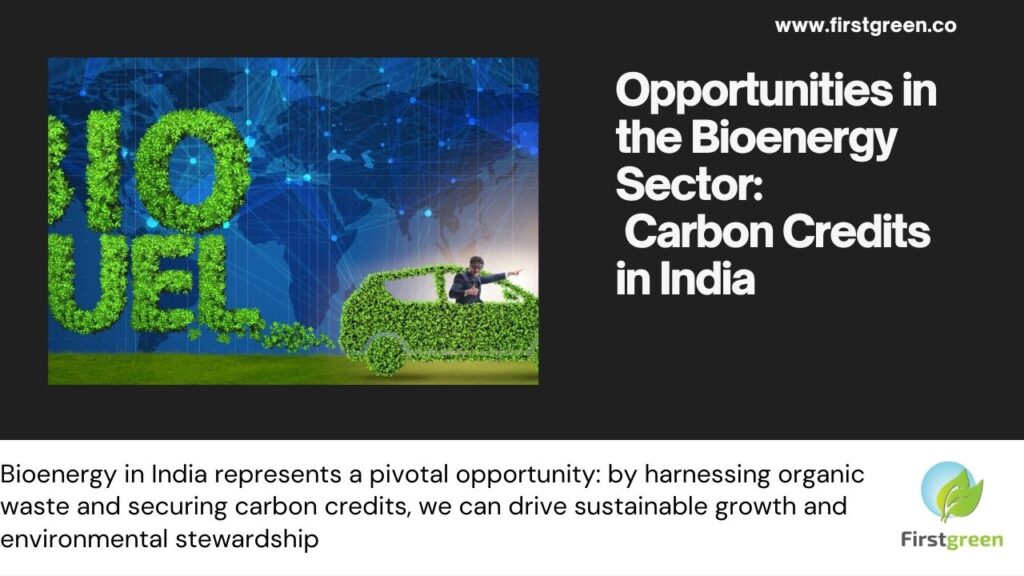
India is rapidly evolving as a global leader in sustainable development, with ambitious targets to combat climate change and transition to a low-carbon economy. One of the most promising areas of this transition is the bioenergy sector, which not only offers substantial environmental benefits but also presents lucrative opportunities for carbon credits. This article delves into the potential of bioenergy in India, the role of carbon credits, and how businesses and investors can capitalize on this emerging market.
The Rise of Bioenergy in India
Bioenergy, derived from organic materials such as agricultural residues, wood, and waste, plays a crucial role in India’s energy landscape. As the country seeks to reduce its dependence on fossil fuels and mitigate greenhouse gas (GHG) emissions, bioenergy offers a sustainable alternative that can contribute significantly to energy security and rural development.
Key Drivers of Bioenergy Growth:
- Government Policies and Incentives: The Indian government has introduced several policies to promote bioenergy, including the National Bioenergy Policy and various state-level initiatives. These policies offer financial incentives, subsidies, and support for research and development in bioenergy technologies.
- Agricultural Residues and Waste Utilization: India generates vast quantities of agricultural residues and organic waste, which can be efficiently converted into bioenergy. Utilizing these resources reduces waste management challenges and provides additional income sources for farmers and rural communities.
- Technological Advancements: Innovations in bioenergy technologies, such as advanced biogas systems, biofuels, and biomass power plants, are improving efficiency and reducing costs. These advancements make bioenergy a more viable and competitive option compared to traditional energy sources.
Carbon Credits: A Key Opportunity
Carbon credits represent a valuable financial instrument in the fight against climate change. They allow businesses and organizations to offset their carbon emissions by investing in projects that reduce or remove GHG emissions. In the context of bioenergy, carbon credits can be generated through various activities, including:
- Biomass Power Generation: Power plants that use biomass as a fuel source can generate carbon credits by displacing fossil fuels and reducing GHG emissions. These credits are particularly valuable in a market where carbon pricing and trading systems are becoming more prevalent.
- Biogas Production: Biogas plants that convert organic waste into renewable energy produce carbon credits by reducing methane emissions from waste. Methane is a potent GHG, and capturing it for energy use significantly mitigates its impact on the environment.
- Biofuel Production: The production of biofuels, such as ethanol and biodiesel, from agricultural residues and dedicated energy crops can generate carbon credits. Biofuels reduce reliance on fossil fuels and lower carbon emissions from transportation.
- Forest and Land Use Projects: Bioenergy projects that involve afforestation, reforestation, or improved land management can also generate carbon credits. These activities enhance carbon sequestration and contribute to broader climate goals.
Navigating the Carbon Credit Market in India
India is developing a robust carbon credit market to facilitate the trading and issuance of carbon credits. The Indian Carbon Market, established under the Energy Conservation Act and the Bureau of Energy Efficiency (BEE), includes both compliance and voluntary mechanisms.
Compliance Mechanism:
The compliance mechanism focuses on sectors with mandatory emission reduction targets. Organizations in these sectors can meet their targets through carbon credits generated from bioenergy projects. The Indian government has set clear guidelines for the validation and verification of these credits to ensure their credibility and effectiveness.
Voluntary Market:
The voluntary carbon market allows businesses and individuals to invest in carbon reduction projects on a voluntary basis. Bioenergy projects can participate in this market, providing an additional revenue stream for project developers and a way for companies to demonstrate their commitment to sustainability.
Opportunities for Businesses and Investors
The bioenergy sector presents several opportunities for businesses and investors in India:
- Investment in Bioenergy Projects: Investing in bioenergy infrastructure, such as biomass power plants, biogas facilities, and biofuel production units, offers attractive returns. With the added benefit of carbon credits, these investments become more financially viable.
- Partnerships and Collaborations: Collaborating with local communities, technology providers, and research institutions can enhance project outcomes and unlock additional funding opportunities. Public-private partnerships are particularly effective in scaling up bioenergy initiatives.
- Market Expansion: As the demand for carbon credits grows, bioenergy projects have the potential to access international markets. This global reach can increase revenue and attract foreign investment in India’s bioenergy sector.
- Sustainability Reporting and Branding: Companies that invest in bioenergy projects and acquire carbon credits can leverage these initiatives for sustainability reporting and branding. Demonstrating environmental responsibility can enhance corporate reputation and attract environmentally-conscious consumers and investors.
Conclusion
The bioenergy sector in India holds immense potential for both environmental and economic benefits. By leveraging carbon credits, businesses and investors can not only contribute to the country’s climate goals but also capitalize on a growing market with significant returns. As India continues to advance its sustainability agenda, the integration of bioenergy and carbon credits will play a pivotal role in shaping a greener and more resilient future.
Embracing these opportunities now can position stakeholders at the forefront of India’s clean energy transition, driving progress and prosperity in the years to come.
